Failing emissions: high CO but the ACV checked out
#26
Can you name every mod you have that affects boost? Intake system, exhaust system, boost control, vacuum lines, ECU. The restricter pills raise the boost by limiting the amount of air that can vent from the wastegate actuator. More restricter pill restriction = higher boost, no restricter pills = lower boost. I doubt the engine is getting into secondary turbo operation on the test cycle btw. I do this for a living, so let's look at the datalog they supplied you with:
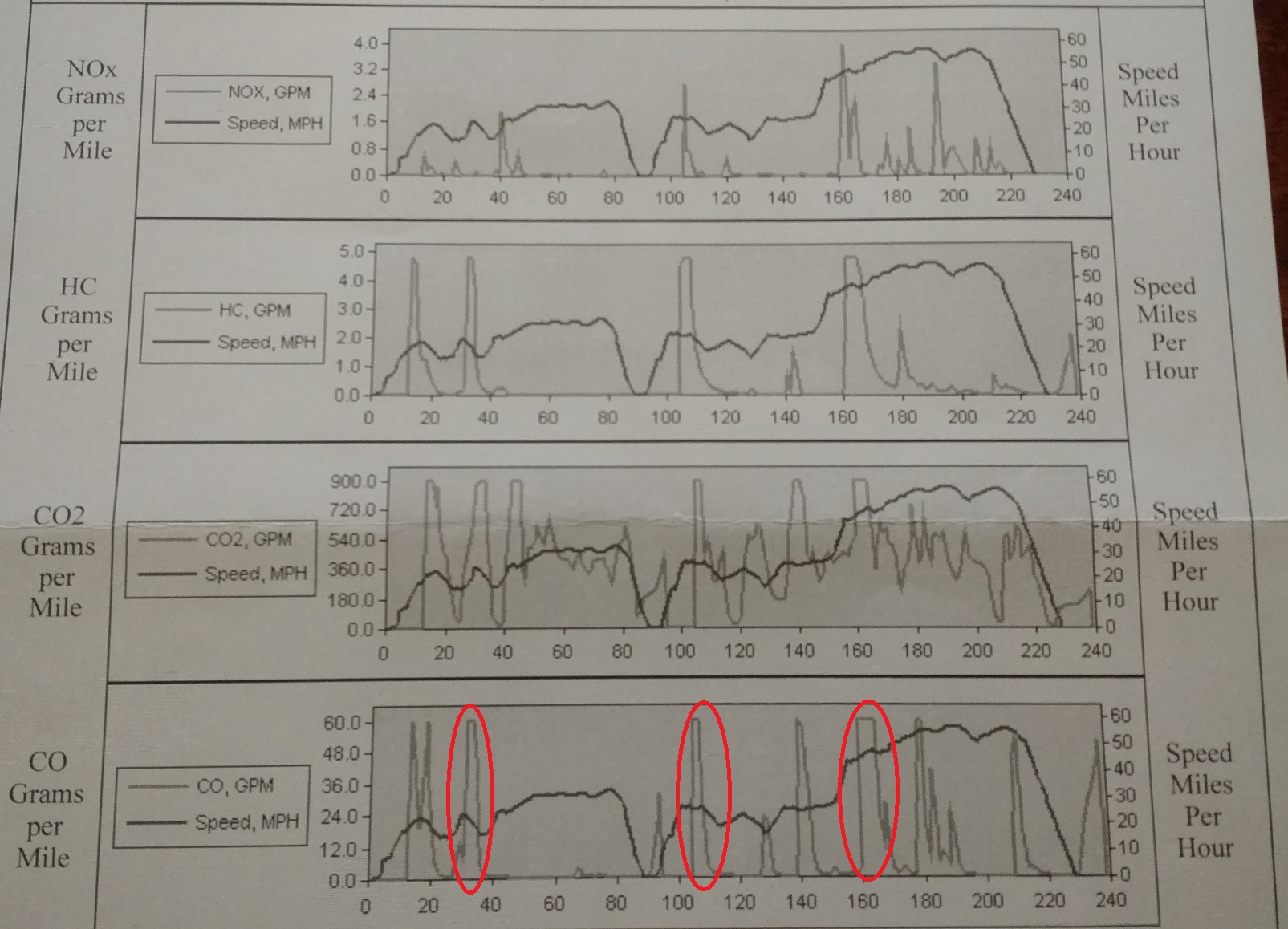
The little spiky ones aren't a big deal, so you want to look at all the points that look like a square in the pattern . I have circled them in red. In those you are clipping the range of the CO analyzer (or at least maxing the range on the chart) which is why it's a square: you're blowing tons of CO through there. At about 155 seconds there is an acceleration which is probably in 3rd or 4th gear, loading the engine down. This is showing up at 160 seconds due to the delay in the analyzer. It looks like the 160 second one might be what made you fail the test more than anything else.
Here is the target AFR "zone" map from the service highlights document:
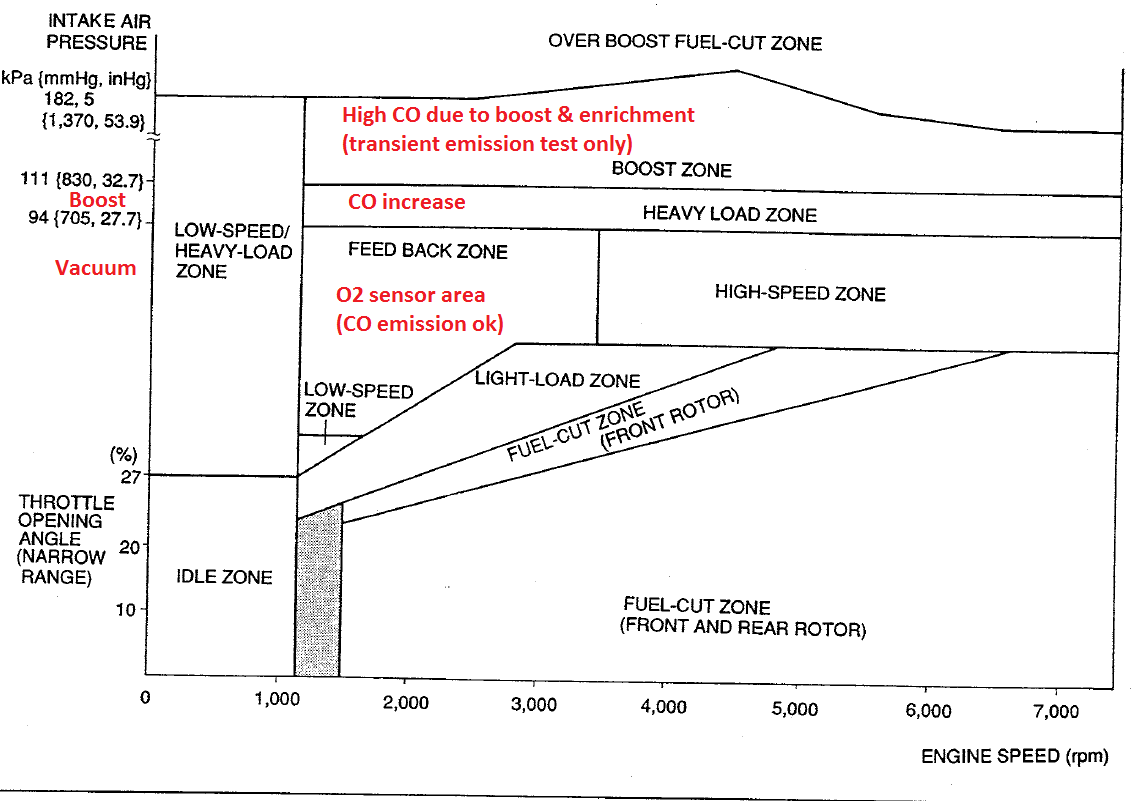
And here is the Secondary Air (air pump) "zone" map:

On a steady mph test and in portions of this IM240 test (like the 50-80 second mark), you are going to mostly be in the above "Feedback zone." This is where the condition of the o2 sensor is important for CO and NOx. If it's biasing one way or the other you will see CO emission break through the cat. Look back at the 60 second mark from your datalog. Do you see significant NOx or CO spikes? No, you don't. This is a good indication that the O2 sensor is ok, and possibly the secondary air. Every major acceleration though you are blowing CO through the cat. This is because the engine is going rich, and the catalyst runs out of oxygen to convert it.
Any mod that changes the throttle angle vs boost relationship to make it more responsive or more torquey is going to increase transient CO emissions. That includes anything that affects boost. The reason for this is that aftermarket ECUs and non modern stock ECUs just have dumb look up tables of speed & boost (or some other load calculation) vs target AFR. Instead of a simple "zone" map like the FD has, on most modern ECUs they calculate the temperature of the catalytic converter and delay going rich in order to drop the CO emission and improve the fuel economy. On a stricter emission test (for a modern light duty vehicle) you pretty much can only have one or two CO spike, in a much longer test cycle, or it will fail. Here all we need to do is reduce your worst CO spikes and you'll pass.

The little spiky ones aren't a big deal, so you want to look at all the points that look like a square in the pattern . I have circled them in red. In those you are clipping the range of the CO analyzer (or at least maxing the range on the chart) which is why it's a square: you're blowing tons of CO through there. At about 155 seconds there is an acceleration which is probably in 3rd or 4th gear, loading the engine down. This is showing up at 160 seconds due to the delay in the analyzer. It looks like the 160 second one might be what made you fail the test more than anything else.
Here is the target AFR "zone" map from the service highlights document:

And here is the Secondary Air (air pump) "zone" map:

On a steady mph test and in portions of this IM240 test (like the 50-80 second mark), you are going to mostly be in the above "Feedback zone." This is where the condition of the o2 sensor is important for CO and NOx. If it's biasing one way or the other you will see CO emission break through the cat. Look back at the 60 second mark from your datalog. Do you see significant NOx or CO spikes? No, you don't. This is a good indication that the O2 sensor is ok, and possibly the secondary air. Every major acceleration though you are blowing CO through the cat. This is because the engine is going rich, and the catalyst runs out of oxygen to convert it.
Any mod that changes the throttle angle vs boost relationship to make it more responsive or more torquey is going to increase transient CO emissions. That includes anything that affects boost. The reason for this is that aftermarket ECUs and non modern stock ECUs just have dumb look up tables of speed & boost (or some other load calculation) vs target AFR. Instead of a simple "zone" map like the FD has, on most modern ECUs they calculate the temperature of the catalytic converter and delay going rich in order to drop the CO emission and improve the fuel economy. On a stricter emission test (for a modern light duty vehicle) you pretty much can only have one or two CO spike, in a much longer test cycle, or it will fail. Here all we need to do is reduce your worst CO spikes and you'll pass.
#27
I'll have a Coke!
Thread Starter
Intake system, exhaust system, boost control, vacuum lines, ECU.
I doubt the engine is getting into secondary turbo operation on the test cycle btw.
This is showing up at 160 seconds due to the delay in the analyzer. It looks like the 160 second one might be what made you fail the test more than anything else.
On a stricter emission test (for a modern light duty vehicle) you pretty much can only have one or two CO spike, in a much longer test cycle, or it will fail. Here all we need to do is reduce your worst CO spikes and you'll pass.
#28
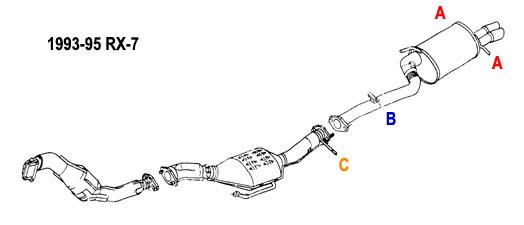
so only the catback (A and B) is aftermarket? What brand? Do you have a stock catback? put a regular paper air filter in if you have a K&N drop in. More restriction will make it spool slower. You just want to reduce any spiking on spool up. Most importantly though you should talk to the tech and ask him to drive it easy, as easy as he can get away with without getting flagged. Maybe you can make it worth his while.
quickest thing you can try is remove the restricter pills to drop the boost, then take it back to the station and ask them to drive it easy. I would do that before messing with the exhaust. A throttle, even an old cable throttle, is a non linear thing. Once you get to about 30 percent pedal angle you are almost WOT.
Last edited by arghx; 09-26-17 at 05:56 AM.
#29
Moderator
iTrader: (3)
Join Date: Mar 2001
Location: https://www2.mazda.com/en/100th/
Posts: 30,802
Received 2,577 Likes
on
1,831 Posts
that being said, in a stock twin car a big throttle application will see 1-2psi of boost, which is enough to take it out of closed loop. there is no way its seeing more boost than that, the test is only 25mph, and the car is really fast.
maybe a more gentle tester is in order?
#30
the test is usually done in 2nd for the 15mph part, and 3rd for the 25mph part, most cars run ~1800-2200rpm, so its right in that sweet spot where its in Feedback AND Port Air.
that being said, in a stock twin car a big throttle application will see 1-2psi of boost, which is enough to take it out of closed loop. there is no way its seeing more boost than that, the test is only 25mph, and the car is really fast.
maybe a more gentle tester is in order?
that being said, in a stock twin car a big throttle application will see 1-2psi of boost, which is enough to take it out of closed loop. there is no way its seeing more boost than that, the test is only 25mph, and the car is really fast.
maybe a more gentle tester is in order?
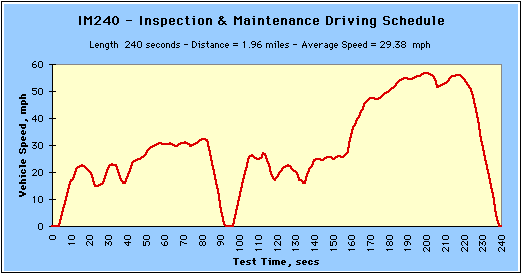
Last edited by arghx; 09-26-17 at 05:57 AM.
#31
Thanks, I'll check them out, I heard Precision Imports at W. Hampton and Federal is supposed to be good too.
EDIT: oh you mean the air care station, might be worth a shot. It's definitely out of my way but if I keep having trouble with the golden station I might make the trip.
EDIT: oh you mean the air care station, might be worth a shot. It's definitely out of my way but if I keep having trouble with the golden station I might make the trip.
arghx - man you know a lot about emissions! All I did was made sure all my emissions components were functioning, adjusted the TPS, got it hot, and brought it in. I honestly didn't think it would pass.
That said, the only big adjustment I ended up making was the TPS... it was pretty far out of spec. Have you measured the voltage output of the TPS on a warm engine? Mine was easy to check with the Power FC. I don't know if it has any effect on emissions... maybe arghx can chime in?
#33
Always Bad Advice
There is some confusion by many folks here on the type of testing being conducted in Colorado. In actuality it has become the wild west in testing procedures since the EPA has given the states leeway in choosing the appropriate tests in locations that have failed to meet clean air standards. Here is an article explaining the history of regular emissions testing and the evolution of the IM240 test from a emissions certification test conducted by vehicle manufacturers under laboratory conditions, to a ubiquitous tail pipe tests conducted thousands a times a day at hundreds of testing stations.
Last edited by mdp; 09-26-17 at 10:54 AM.
#34
I can chime in on that. From a policy perspective, it's clearly a mess, with all the differing requirements. I'm not sure - do they require an IM240 test if you have an OBD II car, or do they just plug in and check for codes/emission monitor readiness? Maybe that varies by the locality. OBD II has been out for over 20 years now so how many old cars are you really going to test? Then you've got all those repair costs which tend to hit lower income people, and a minimum amount of money you have to pay before they give you financial relief--a sacrifice to the low emissions gods you could say.
From a technical perspective, the IM240 is similar to certification tests (like the US FTP75, US06, and SC03 tests, the Euro NEDC or WLTP tests, or the Japanese JC08) but is actually much much easier. It's a short test, it doesn't require the engine to sit overnight and cold start (either at room temperature or in a cold chamber), it doesn't require you to shut the engine down and heatsoak for 10 minutes. The test limits are not that difficult to pass for any 100% stock car with all the equipment working. It doesn't run at very high speeds and doesn't accelerate that aggressively. An IM240 test has a better chance of detecting a tuned car that has all the emissions check engine lights disabled in the software. It also has a better chance of catching an engine that is wearing out and burning a lot of oil. So if all you cared about were emissions, really every car should run an IM240. Now I'm not advocating that as a public policy, I'm just pointing out that from a technical perspective you are going to catch a lot more polluting cars with a transient test. People have to decide if catching those extra number of cars is worth the cost and the hassle.
A roller dyno test that includes a cold start isn't feasible for a high volume of cars, so a short hot test like an IM240 makes sense. However, on modern cars CARB requires a "cold start strategy diagnostic monitor." This calculates whether the emissions controls used during cold start are working correctly. It will make sure that the spark and injection are functioning in such a way as to heat up the converter, by doing things like calculating the heat transfer from the exhaust into the cat. Then it will throw a code if that's not working. The whole idea is to make the stock ECU's so smart that you don't need to do any dyno tests to detect emissions. As I mentioned though, modern cars that allow the stock ECU to be reflashed will have the capability of disabling all that emission control stuff and tricking the inspection computer into thinking everything is fine. That's where visual inspections and dyno tests fit in, again from the perspective of maximizing the number of polluting vehicles caught rather than keeping money and hassle minimized.
From a technical perspective, the IM240 is similar to certification tests (like the US FTP75, US06, and SC03 tests, the Euro NEDC or WLTP tests, or the Japanese JC08) but is actually much much easier. It's a short test, it doesn't require the engine to sit overnight and cold start (either at room temperature or in a cold chamber), it doesn't require you to shut the engine down and heatsoak for 10 minutes. The test limits are not that difficult to pass for any 100% stock car with all the equipment working. It doesn't run at very high speeds and doesn't accelerate that aggressively. An IM240 test has a better chance of detecting a tuned car that has all the emissions check engine lights disabled in the software. It also has a better chance of catching an engine that is wearing out and burning a lot of oil. So if all you cared about were emissions, really every car should run an IM240. Now I'm not advocating that as a public policy, I'm just pointing out that from a technical perspective you are going to catch a lot more polluting cars with a transient test. People have to decide if catching those extra number of cars is worth the cost and the hassle.
A roller dyno test that includes a cold start isn't feasible for a high volume of cars, so a short hot test like an IM240 makes sense. However, on modern cars CARB requires a "cold start strategy diagnostic monitor." This calculates whether the emissions controls used during cold start are working correctly. It will make sure that the spark and injection are functioning in such a way as to heat up the converter, by doing things like calculating the heat transfer from the exhaust into the cat. Then it will throw a code if that's not working. The whole idea is to make the stock ECU's so smart that you don't need to do any dyno tests to detect emissions. As I mentioned though, modern cars that allow the stock ECU to be reflashed will have the capability of disabling all that emission control stuff and tricking the inspection computer into thinking everything is fine. That's where visual inspections and dyno tests fit in, again from the perspective of maximizing the number of polluting vehicles caught rather than keeping money and hassle minimized.
#35
from the perspective of CO emissions, OP's IM240 test is nowhere near as challenging as the EPA US06 test used in certification (which wasn't around when the FD was a new vehicle):
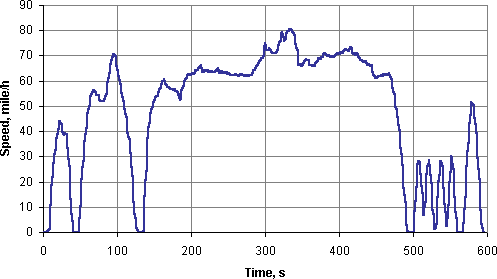
Even the current Euro cycle (NEDC cycle, note km/h on Y axis instead of mph) would be tough:
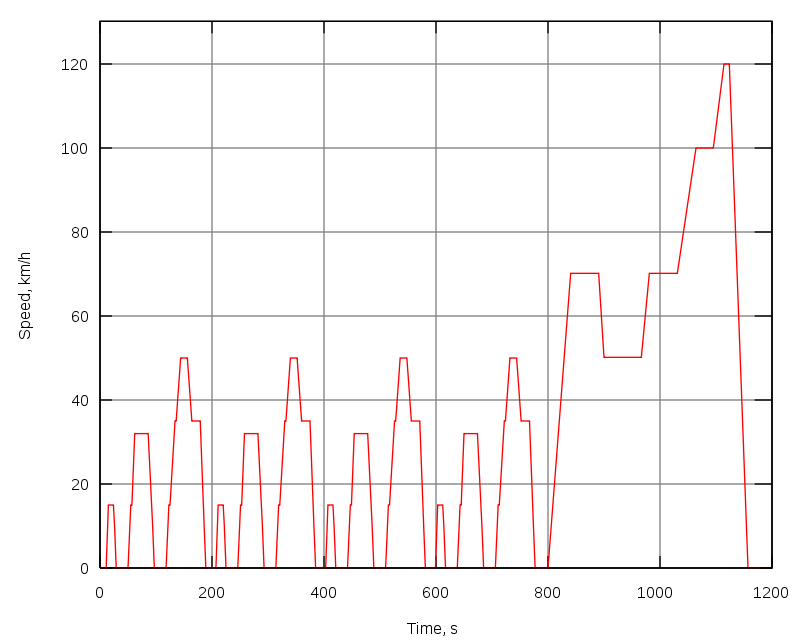
This is the test the FD was designed for, US FTP75 test (cold starting the engine after sitting overnight at 75F temperature):
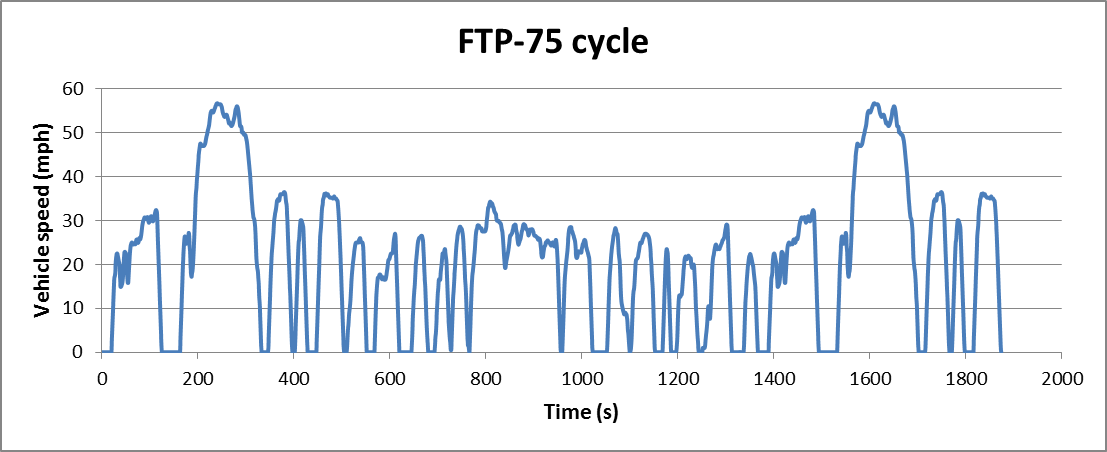
That was developed when some guy in the 1960s drove around the LA area and said "ok, this is a typical American commute." The Japanese cycle was very easy, because it is basically the equivalent of stop and go traffic in Tokyo, with no major acceleration required.

Even the current Euro cycle (NEDC cycle, note km/h on Y axis instead of mph) would be tough:

This is the test the FD was designed for, US FTP75 test (cold starting the engine after sitting overnight at 75F temperature):

That was developed when some guy in the 1960s drove around the LA area and said "ok, this is a typical American commute." The Japanese cycle was very easy, because it is basically the equivalent of stop and go traffic in Tokyo, with no major acceleration required.
Last edited by arghx; 09-26-17 at 11:40 AM.
#36
I'll have a Coke!
Thread Starter

so only the catback (A and B) is aftermarket? What brand? Do you have a stock catback? put a regular paper air filter in if you have a K&N drop in. More restriction will make it spool slower. You just want to reduce any spiking on spool up. Most importantly though you should talk to the tech and ask him to drive it easy, as easy as he can get away with without getting flagged. Maybe you can make it worth his while.
quickest thing you can try is remove the restricter pills to drop the boost, then take it back to the station and ask them to drive it easy. I would do that before messing with the exhaust. A throttle, even an old cable throttle, is a non linear thing. Once you get to about 30 percent pedal angle you are almost WOT.
Good deal, I will make sure to talk with the tech before he drives it.
#37
I'll have a Coke!
Thread Starter
There is some confusion by many folks here on the type of testing being conducted in Colorado. In actuality it has become the wild west in testing procedures since the EPA has given the states leeway in choosing the appropriate tests in locations that have failed to meet clean air standards.
#38
Moderator
iTrader: (3)
Join Date: Mar 2001
Location: https://www2.mazda.com/en/100th/
Posts: 30,802
Received 2,577 Likes
on
1,831 Posts
There is some confusion by many folks here on the type of testing being conducted in Colorado. In actuality it has become the wild west in testing procedures since the EPA has given the states leeway in choosing the appropriate tests in locations that have failed to meet clean air standards. Here is an article explaining the history of regular emissions testing and the evolution of the IM240 test from a emissions certification test conducted by vehicle manufacturers under laboratory conditions, to a ubiquitous tail pipe tests conducted thousands a times a day at hundreds of testing stations.
our test is just to hold 15mph for up to 120 seconds, then hold 25 mph for up to 90 seconds. if the car is really clean or really dirty the test is shorter. ours are also HC as a PPM, FD's are generally allowed about 80, CO is a percent, FD's are allowed about 0, and nox is some random number, we're usually allowed 450 of them, it makes big swings.
#39
wow thats crazy, what happens when someones car falls off the dyno?
our test is just to hold 15mph for up to 120 seconds, then hold 25 mph for up to 90 seconds. if the car is really clean or really dirty the test is shorter. ours are also HC as a PPM, FD's are generally allowed about 80, CO is a percent, FD's are allowed about 0, and nox is some random number, we're usually allowed 450 of them, it makes big swings.
our test is just to hold 15mph for up to 120 seconds, then hold 25 mph for up to 90 seconds. if the car is really clean or really dirty the test is shorter. ours are also HC as a PPM, FD's are generally allowed about 80, CO is a percent, FD's are allowed about 0, and nox is some random number, we're usually allowed 450 of them, it makes big swings.
What happens if cars fall off the dyno? Well, that's what insurance is for. I bet insurance for IM240 testing stations is more expensive. That's why I'm saying that from a purely technical/emissions perspective, IM240 all the things. From a policy standpoint there's a lot more to consider.
#40
Sorry for the confusion, it's a franken-exhaust. The previous owner had a 3" downpipe on it, and the dealer chopped & welded in a pre-cat. I then put in a RB cat-back. Then two years ago, I asked my mechanic to get a 3" main cat so I would have a full 3" exhaust. I should have just got a 3" Bonez DP+main cat.
Good deal, I will make sure to talk with the tech before he drives it.
Good deal, I will make sure to talk with the tech before he drives it.
#41
Always Bad Advice
I didn't see where Phu5ion mentioned which brand of cat he replaced the stock cat with. But, I do recall, over the last 20 years, on the big list and this forum, that there were three members with similar problems. We all went round and round trying to figure out what was causing the repeated failure in emissions testing on these stock cars. I believe one or two of them had new aftermarket catalytic converters. As I recall, after eliminating all other possibilities, two people finally coughed up the bucks and installed a new Mazda catalytic converter and the other borrowed a know good OEM converter. All three passed after installation of the OEM converters. I would say that after making sure everything else is working to OEM specifications that you are left with trying an new, or known good, OEM converter if you don't already have one.
#42
I didn't see where Phu5ion mentioned which brand of cat he replaced the stock cat with. But, I do recall, over the last 20 years, on the big list and this forum, that there were three members with similar problems. We all went round and round trying to figure out what was causing the repeated failure in emissions testing on these stock cars. I believe one or two of them had new aftermarket catalytic converters. As I recall, after eliminating all other possibilities, two people finally coughed up the bucks and installed a new Mazda catalytic converter and the other borrowed a know good OEM converter. All three passed after installation of the OEM converters. I would say that after making sure everything else is working to OEM specifications that you are left with trying an new, or known good, OEM converter if you don't already have one.
#43
I'll have a Coke!
Thread Starter
#44
I'll have a Coke!
Thread Starter
I'll ask about where they got the main cat from, but it's most likely some generic supplier. The car's airpump and O2 sensor is finally getting tested today. With any luck I might be able to get the car back, remove the restrictor pills, and test again on Saturday.
#45
Senior Member
iTrader: (2)
So I'm failing emissions with high carbon monoxide, and it keeps coming up as being air control valve related. I was able to get an emissions exemption from the state 2 years ago and they thought it was the ACV as well, so that winter I tore into the engine, pulled out the ACV and bench tested the unit. All the valves and solenoids on the ACV checked out, and I also retested the secondary air switching and bypass solenoids, and they all operate within spec, triple checked my vacuum hose diagram, and put it back together.
I can see the clutch engaging on the airpump, but the only thing I haven't been able to verify is that the airpump is putting out pressure. I've asked my mechanic to check that first before disassembling the intake system. Is there anything else I could have missed?
I can see the clutch engaging on the airpump, but the only thing I haven't been able to verify is that the airpump is putting out pressure. I've asked my mechanic to check that first before disassembling the intake system. Is there anything else I could have missed?
#46
I'll have a Coke!
Thread Starter
Took a lot longer to get back there than I expected, life happens, but here's the update. I pulled out the restricter pills, pinched off the catch can purge line, tires were already up at 37PSI, and filled the tank without any more premix. When I got there, I talked the manager and explained that some of his techs were out accelerate the program and blowing my CO through the roof, so he drove my car, did a great job and brought my CO from 25GPM down to 9GPM with a 15GPM limit.
Thank you to everyone for helping me out.
As for my overboosting... Well, there's my problem.
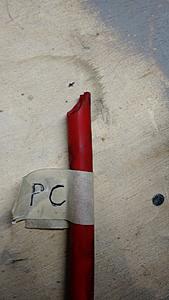
And a few were interested in the facility so here are a couple of shots at their rolling road.
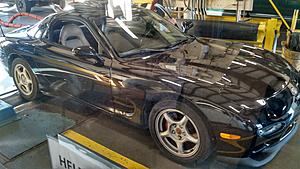
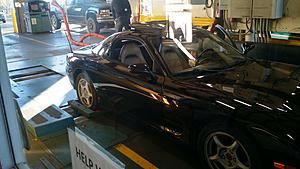
Thank you to everyone for helping me out.
As for my overboosting... Well, there's my problem.

And a few were interested in the facility so here are a couple of shots at their rolling road.


Last edited by Phu5ion; 10-25-17 at 11:17 AM.

